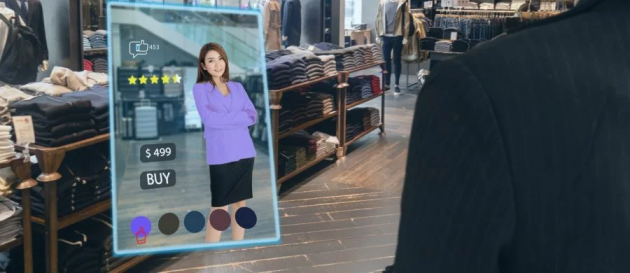AR for retail has been heralded as the thing to watch for a long time. Now it’s arrived. And it’s something many consumers expect from the businesses they buy from.
Augmented Reality Shopping
Augmented Reality shopping really took off in 2020 when consumers were unable to try on items and returns processes had to change. Brands like Sephora allowed customers to test different makeup looks, and even style them to their outfits.
The biggest take up of the AR shopping experience was in the furniture industry. IKEA’s Augmented Reality has been leading the way for many years. They created an iPhone app – IKEA Place – to help customers match the style, colour and size of furniture to their home. Dulux created the Dulux Visualiser App which allows customers to blend different colours before they find the perfect match for their home. And Lowe’s took it a step further, partnering with Microsoft’s HoloLens to help customers really visualise the products and see how they fit in their home.
Perhaps the most obvious use of AR in retail is with an Augmented Reality fashion experience. Topshop’s virtual fitting room, the Kinect Fitting Room, allowed customers to skip the queues and instead try on clothes using a screen.
One of the earliest and best adopters of Augmented Reality is Nike. This includes everything from finding the right size trainers for your feet using an AR function in the Nike fit app. To using Nike Augmented Reality to fight off bots and sell limited edition trainers.
B2B Augmented Reality
Augmented Reality has become a fantastic way for B2C companies to connect with their customers and bring new experiences to the retail experience. But what about B2B Augmented Reality?
The technology has taken off in this space. Here are some of our favourite B2B Augmented Reality apps:
Using AR to bring products to life
Pipelife Latvia used B2B AR to allow customers to turn 2D models into 3D models of piping systems, before seeing 3D versions of the parts they needed for the system. They could then click these products to find out more about them.
Simplifying the shopping experience
Caterpillar creates heavy machinery which is difficult to bring to trade shows or view on a more micro level. Their use of Augmented Reality technology allows customers to view a tractor with over 6,000 part numbers, hovering over each part to see a 3D version and its advanced features.
Standing out in an exhibition space
Ford used AR to solve the notorious problem of holding visitors’ attention at trade shows, where there are hundreds of exhibitors to choose from. Their AR tech allowed potential customers to see under the hood of the Ford GT, F-150 pickup and the EcoSport SUV.
Creating a buzz at trade shows
Kawasaki had the same problem at the mDevCamp show in Europe. At ADAMAPP we came up with a solution, using our AR configurator to create a buzz around their stall and ultimately drive new leads and brand awareness to their new product. Customers entered the booth and met our robot receptionist, Pepper, before using AR to create their dream motorbike. They could change colours and other features and even see themselves sitting on the bike they created.
Visualising complex problems and data
IBM has long been at the forefront of technology. And it’s no different with Augmented Reality. Their B2B AR solution allows customers to visualise data in 3D, helping them see more patterns and solutions to problems.
Augmented Reality Retail Examples
Altered Reality apps are improving the shopping experience like never before. They’re allowing retail stores to combine technology with the offline shopping experience. From Augmented Reality fashion solutions to Augmented Reality shopping for furniture or even cars, there’s a solution for almost every product. Here are some of our favourite Augmented Reality retail examples.
Finding the right product for you
The Amazon AR View app allows customers to completely design their space before buying products. This solves one of Amazon’s problems, which is that there are too many products on the website for customers to choose from. Narrowing it down to the one which best suits your space helps avoid overwhelm from all of the options.
Differentiating products with AR apps
L’Oreal Paris has heavily invested in their retail Augmented Reality, with some spectacular results. Customers can try on different hair colours and make up using their technology. They can also use the Skin Genius app, which helps them to choose the right products for their skin type.
Selling high value products using AR
De Beers created a solution to bring fittings to the online world. Their Augmented Reality app allows customers to try on diamonds from their Forevermark diamond brand. It’s an innovative solution and perhaps the first use of AR in the jewellery industry.
Augmented Reality fashion
The Gap dressing room AR app is a virtual app allowing customers to try on clothes virtually. The AR shopping experience brings the clothes to customers, wherever they are.
AR in retail: Bringing online offline
Houzz View My Room in 3D allows customers to see products as they’d look in their homes. It brings the offline experience to the online world, and allows for Houzz’s recommended products solution to shine.
Solving a problem with AR apps
Magnolia Market – the Shopify AR app was an inspired solution to problems created in 2020, when many consumers had the time to improve their home, but weren’t able to visit physical shops. This AR allows customers to view everything from sofas to vases in their own home, in beautiful 3D.
Looking for a solution for your business? Find out more about the incredible technology we create, browse our products or services. Or contact us to find out how we can help you.
Want to find out more about Augmented Reality in 2021? Visit our blog.

